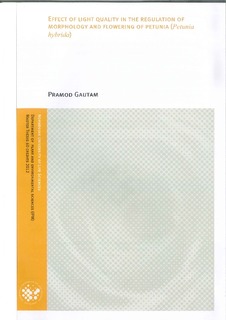| dc.description.abstract | Manipulation of plant morphology is greatly important for commercial use of ornamental plants. Use of chemical is an effective option for growth manipulation but of environment concern. Temperature manipulation is also an option but is not found practical in all greenhouse systems or in all seasons. Manipulation in light quality may be a practical and effective option in petunia. Therefore, the main aim of the study was to investigate the effect of red and blue light and far red absorbing film (solatrol), alone and in combination, in the manipulation of morphology of two cultivars of petunia 'Tidal Wave' and 'Mambo Formula Mixture'. Two experiments were conducted, the first one was conducted in early spring (March-April) and the second was conducted in summer (May-June). Three types of treatments i.e., blue-LED, red-LED (50 μmol m-2s-1) and control were executed under solatrol and under shade of white plastic, compared with control (no additional light). Cultivar 'Tidal Wave' was found to be more responsive than 'Mambo Formula Mixture' to light quality manipulation by using solatrol or by using red or blue LED. However, in case of parameters - days to visible bud and days to flowering, 'Mambo Formula Mixture’ was more responsive. In the cultivar 'Tidal Wave', plant height was found to be 70% shorter in solatrol + red-LED compared to shade + blue-LED, which showed the tallest plants and it was found to be 40 % shorter compared to shade + red-LED. In the cultivar ‘Tidal Wave’, the earliest visible bud was seen under shade + red-LED and the latest was found after 3 days under solatrol + red-LED in the spring and solatrol-control in summer. In the cultivar 'Mambo Formula Mixture', the earliest visible buds and flowers were seen under solatrol + blue LED and latest under solatrol – control with the difference of 9 and 5 days respectively. Under solatrol, chlorophyll content was found to be 60%, 9% and 21% greater than under shade with red-LED, control and blue-LED treatment respectively. Solatrol and Red LED were found effective in reducing height alone and in combination. Solatrol delayed flowering with less number of flower whereas blue-LED enhances flowering earlier with highest number of flowers. The results from this study clearly show that light quality can be an effective tool in controlling morphology and flowering in petunia but the responses will vary with cultivars. | no_NO |
